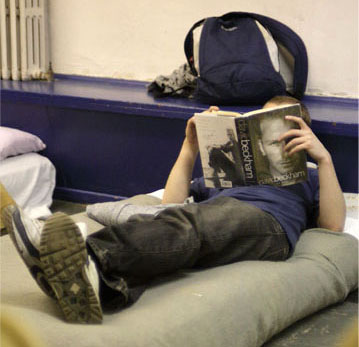
Established 2005 Registered Charity No. 1110656
Scottish Charity Register No. SC043760
DONATE
RECENT TWEETS
“There’s a very important distinction between being a guest at a shelter project and being a client or a service user in the rest of the sector, which implies a professional relationship focusing on people’s problems,” explains Mark Brennan, a shelter coordinator at Housing Justice.
“That’s great, but what the shelters are offering is a chance to be a guest. It’s about inviting people in as you would invite a guest into your own home.”
Right now, winter night shelters are getting back into gear as another season starts. The venues are often churches or mosques, temples, synagogues and community centres, but most welcome guests and volunteers regardless of their religious ideology.
Facilities available range from little more than a mat and sleeping bag, to full cooking and washing facilities on-site. And although winter shelters are not intended to be a long-term solution to homelessness, they can be an important step to improving guests’ quality of life.
In London, each borough has a different maximum length of stay, which could be a few days (while people wait for more secure housing) or the full season, running through until next March. They also work on a rotation system, with each shelter allocated a specific day of the week and guests moving around depending on which shelter is operational that night.
“It’s the circuit model that’s proven to be incredibly successful,” says Brennan. “A venue takes a certain night in a week in any given local authority and they all work together. The whole point is we’re trying to create these spaces where the clinical and the relational come together, because that’s how you get the best outcomes for everyone involved.”
Not everyone agrees that winter shelters are the most valuable form of community outreach. Crispin Green, an advice worker at the Robes Project, which runs a winter night shelter, says many branches of the sector argue that winter shelters aren’t well equipped enough to do the job, and government funds for tackling homelessness should be increased in order to eradicate the need for winter shelters, which rely on volunteers.
Green argues: “The way we operate should be seen as a complement to other services. The winter shelters aren’t discriminating or putting down boundaries and borderlines, saying who they will or won’t help. We see people coming from outside London, the rest of Europe, asylum seekers, overstayers who have got into trouble – people who can’t be helped by Council-based services.”
Where possible, winter shelters work alongside other services to help guests with debt advice, mediation, future accommodation and other needs. Last year, more than a third of winter shelter guests moved on to other accommodation, including council housing, hostels and private rentals.
The problem is not just that other services underestimate the importance of the shelters, but that until recently some were unaware they even existed. “I didn’t know about winter shelters really until I came into the work myself,” says Green. “I didn’t know the lengths to which many churches and volunteers will go to in order to operate these projects in the winter. Some of them have been going for a long time without other services being aware of them.”
Crucially, winter shelters provide a sense of community and a safe space to literally get people off the street, accommodating as many rough sleepers as possible, particularly when the temperatures drop below zero.
Karen had lived in Hackney for over 30 years, but when her husband died she found herself suffering with depression and sciatica, unable to pay the bills and eventually sleeping on the street. She was referred to a winter shelter by a key worker. “When she told me I had a place I couldn’t believe it,” says Karen. “I was so excited but I just couldn’t get my hopes up. I kept worrying it would fall through. I only let myself get happy about it when I knew it was secure.”
She was able to make friends at the Hackney Winter Night Shelter and build a sense of security and community.
She left determined to put her PhD to use and get a job, like the people she saw going to work in the morning and felt envious of.
“I don’t know what would have happened if I hadn’t been referred here,” she says. “To anyone thinking of supporting this shelter, I’d say please do it. Let us have a voice, let us have a chance.”
Get details in the List: www.thepavement.org.uk/services.php
You’ve been turned away by your local authority. So how do you access a winter shelter?
Of the 24 shelters open last year, 21 were located in London, accommodating more than 1,300 guests. More than half were aged between 26 and 49, although people of all ages are welcome.
The method for getting a spot at a winter shelter is slightly different. In Glasgow and Edinburgh, you can just turn up. In London, it’s different in every borough and for each venue; have a look at the listing section for more info.
Check whether you need to be referred – and who by. Some London boroughs such as Tower Hamlets will only take referrals from nominated centres, including Crisis Skylight and Whitechapel Mission, whereas Islington, for example, will take referrals from anywhere. In Barnet, all referrals must come from the local Homeless Action day centre.
Once you have been referred to a shelter, your needs will be assessed by a coordinator as shelters are not appropriate for everyone’s support needs.
And while all shelters have at least one volunteer on site every given night, some are able to provide substantially more support than others, for example help with mental health or addiction.
June – July 2024 : Reflections
CONTENTS
BACK ISSUES
- Issue 150 : June – July 2024 : Reflections
- Issue 149 : April – May 2024 : Compassion
- Issue 148 : February – March 2024 : The little things
- Issue 147 : December 2023 – January 2024 : Next steps
- Issue 146 : October 2023 – November 2023 : Kind acts
- Issue 145 : August 2023 – September 2023 : Mental health
- Issue 144 : June 2023 – July 2023 : Community
- Issue 143 : April 2023 - May 2023 : Hope springs
- Issue 142 : February 2023 - March 2023 : New Beginnings
- Issue 141 : December 2022 - January 2023 : Winter Homeless
- Issue 140 : October - November 2022 : Resolve
- Issue 139 : August - September 2022 : Creativity
- Issue 138 : June - July 2022 : Practical advice
- Issue 137 : April - May 2022 : Connection
- Issue 136 : February - March 2022 : RESPECT
- Issue 135 : Dec 2021 - Jan 2022 : OPPORTUNITY
- Issue 134 : September-October 2021 : Losses and gains
- Issue 133 : July-August 2021 : Know Your Rights
- Issue 132 : May-June 2021 : Access to Healthcare
- Issue 131 : Mar-Apr 2021 : SOLUTIONS
- Issue 130 : Jan-Feb 2021 : CHANGE
- Issue 129 : Nov-Dec 2020 : UNBELIEVABLE
- Issue 128 : Sep-Oct 2020 : COPING
- Issue 127 : Jul-Aug 2020 : HOPE
- Issue 126 : Health & Wellbeing in a Crisis
- Issue 125 : Mar-Apr 2020 : MOVING ON
- Issue 124 : Jan-Feb 2020 : STREET FOOD
- Issue 123 : Nov-Dec 2019 : HOSTELS
- Issue 122 : Sep 2019 : DEATH ON THE STREETS
- Issue 121 : July-Aug 2019 : INVISIBLE YOUTH
- Issue 120 : May-June 2019 : RECOVERY
- Issue 119 : Mar-Apr 2019 : WELLBEING
- Issue 118 : Jan-Feb 2019 : WORKING HOMELESS
- Issue 117 : Nov-Dec 2018 : HER STORY
- Issue 116 : Sept-Oct 2018 : TOILET TALK
- Issue 115 : July-Aug 2018 : HIDDEN HOMELESS
- Issue 114 : May-Jun 2018 : REBUILD YOUR LIFE
- Issue 113 : Mar–Apr 2018 : REMEMBRANCE
- Issue 112 : Jan-Feb 2018
- Issue 111 : Nov-Dec 2017
- Issue 110 : Sept-Oct 2017
- Issue 109 : July-Aug 2017
- Issue 108 : Apr-May 2017
- Issue 107 : Feb-Mar 2017
- Issue 106 : Dec 2016 - Jan 2017
- Issue 105 : Oct-Nov 2016
- Issue 104 : Aug-Sept 2016
- Issue 103 : May-June 2016
- Issue 102 : Mar-Apr 2016
- Issue 101 : Jan-Feb 2016
- Issue 100 : Nov-Dec 2015
- Issue 99 : Sept-Oct 2015
- Issue 98 : July-Aug 2015
- Issue 97 : May-Jun 2015
- Issue 96 : April 2015 [Mini Issue]
- Issue 95 : March 2015
- Issue 94 : February 2015
- Issue 93 : December 2014
- Issue 92 : November 2014
- Issue 91 : October 2014
- Issue 90 : September 2014
- Issue 89 : July 2014
- Issue 88 : June 2014
- Issue 87 : May 2014
- Issue 86 : April 2014
- Issue 85 : March 2014
- Issue 84 : February 2014
- Issue 83 : December 2013
- Issue 82 : November 2013
- Issue 81 : October 2013
- Issue 80 : September 2013
- Issue 79 : June 2013
- Issue 78 : 78
- Issue 77 : 77
- Issue 76 : 76
- Issue 75 : 75
- Issue 74 : 74
- Issue 73 : 73
- Issue 72 : 72
- Issue 71 : 71
- Issue 70 : 70
- Issue 69 : 69
- Issue 68 : 68
- Issue 67 : 67
- Issue 66 : 66
- Issue 65 : 65
- Issue 64 : 64
- Issue 63 : 63
- Issue 62 : 62
- Issue 61 : 61
- Issue 60 : 60
- Issue 59 : 59
- Issue 58 : 58
- Issue 57 : 57
- Issue 56 : 56
- Issue 56 : 56
- Issue 55 : 55
- Issue 54 : 54
- Issue 53 : 53
- Issue 52 : 52
- Issue 51 : 51
- Issue 50 : 50
- Issue 49 : 49
- Issue 48 : 48
- Issue 47 : 47
- Issue 46 : 46
- Issue 45 : 45
- Issue 44 : 44
- Issue 43 : 43
- Issue 42 : 42
- Issue 5 : 05
- Issue 4 : 04
- Issue 2 : 02
- Issue 1 : 01
- Issue 41 : 41
- Issue 40 : 40
- Issue 39 : 39
- Issue 38 : 38
- Issue 37 : 37
- Issue 36 : 36
- Issue 35 : 35
- Issue 34 : 34
- Issue 33 : 33
- Issue 10 : 10
- Issue 9 : 09
- Issue 6 : 06
- Issue 3 : 03
- Issue 32 : 32
- Issue 31 : 31
- Issue 30 : 30
- Issue 29 : 29
- Issue 11 : 11
- Issue 12 : 12
- Issue 13 : 13
- Issue 14 : 14
- Issue 15 : 15
- Issue 16 : 16
- Issue 17 : 17
- Issue 18 : 18
- Issue 19 : 19
- Issue 20 : 20
- Issue 21 : 21
- Issue 22 : 22
- Issue 23 : 23
- Issue 24 : 24
- Issue 25 : 25
- Issue 8 : 08
- Issue 7 : 07
- Issue 26 : 26
- Issue 27 : 27
- Issue 28 : 28
- Issue 1 : 01

